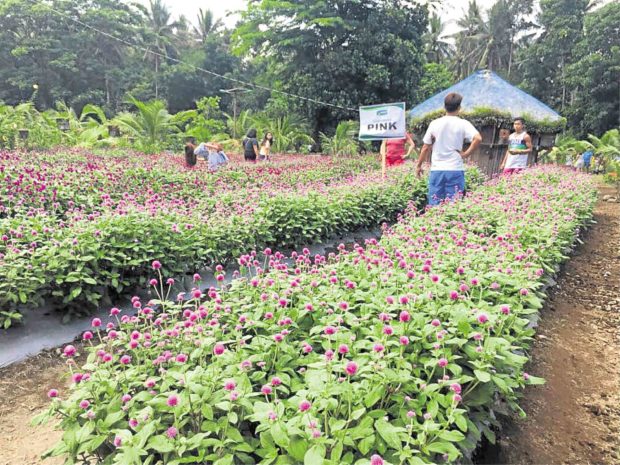
GREEN ATTRACTION At the newly opened Farmers Bounty Village in Camalig, Albay province, visitors learn about farm work amid a relaxing environment surrounded by vegetable plots and flower beds. —PHOTOS BY GEORGE GIO BRONDIAL AND MA. APRIL MIER-MANJARES
LEGAZPI CITY, Albay, Philippines — To improve the lives of farmers and their productivity, especially in the midst of climate change, Albay’s provincial government has opened Farmers Bounty Village, a one-stop shop agricultural complex in Camalig town.
“This is to attract farmers and teach them how to earn more out of agriculture. I want young entrepreneurs to put up their own business and pursue agricultural training,” said Gov. Al Francis Bichara.
Albay was the first to establish such hub in the country, he said.
Formally launched in May, the 15-hectare complex in Barangay Cabagñan has agricultural centers, processing facilities, a farm school and laboratory areas to showcase innovative technologies and best farming practices.
Cheryll Rebeta, provincial agriculturist, said the farm school would help farmers and fisherfolk in coping with the changing climate.
FARM PRODUCTS Cacao wine and charcoal briquettes are among the products sold at Farmers Bounty. —GEORGE GIO BRONDIAL
In April, Albay declared a state of calamity due to the destructive effects of El Niño.
A total of P220,964,787 worth of rice crops were damaged, according to the provincial agriculture office. Corn crops valued at P33,339,102 and vegetables worth P4,239,994 were lost due to the dry spell.
Farm school
At the farm school, students will learn strategies in adapting to changing weather patterns, prolonged drought and other threats to crop cultivation.
Those who want to undergo training in organic agriculture will be offered scholarships from the Technical Education and Skills Development Authority.
Hands-on training sessions will also be held as part of vocational courses—from planting to food processing.
ORGANIC HONEY Angelo Rosalita, caretaker of the bee farm, checks the quality of honey produced by stingless bees. —GEORGE GIO BRONDIAL
SALAD VEGGIES Greenhouses are essential in the proper cultivation of high-value crops, like lettuce and other salad vegetables. —GEORGE GIO BRONDIAL
Farmers can consult the soil laboratory on how to improve soil conditions and proper fertilization.
At the cacao processing and fermentation center, trainees will produce fermented cacao beans, wine, vinegar, “tablea” (native chocolate tablets) and nibbles. End products of sweet potato (camote) and pili will be processed in other facilities.
Farmers can cultivate high-value vegetables, such as arugula, lettuce, cucumber and tomatoes, in the four greenhouses. They can also experiment on growing strawberries and herbal or medicinal plants.
Fresh milk
Dairy livestock breeders have made commitments to ensure that Albay will soon have a sufficient supply of fresh milk and market products to other areas, said Florencio Adunay, who is in charge of the dairy plant.
“The farmers’ organizations and cattle are now in the pipeline. Even the carabao and goat dairy farmers will also help. In a year’s time, we can have sufficient milk production to meet the demand of fresh milk in the local market,” Adunay said.
At present, water cannot reach the elevated area where the cattle shed and milking parlor are found due to the dry season.
“We are still looking for remedies for sufficient water supply that can be used in cleaning the milking area. We produce almost 8 liters a day, but it is still contaminated and not fit for human consumption,” Adunay said.
To encourage dairy production, the Albay dairy plant will offer farmers training and seminars on proper milking.
Gerry Reyteran said Farmers Bounty had trained farmers like him so they could expand their knowledge and improve their skills in organic farming.
“I was able to save up to 70 percent of my production expenses because I did not buy fertilizers and pesticides. We were taught techniques in creating [alternative] concoctions using different kinds of leaves,” he said.
Reyteran said he was sharing what he learned to his group of vegetable farmers in Pio Duran town.
Public market
Florito Abiles, who owns a 2-ha farm in the mountain village of Bonga in Ligao City, said: “In our area, it’s hard to look for equipment that we can use during harvest. I hope they can lend us equipment.”
From Thursday to Saturday, the trading center serves as a public market where naturally grown vegetables, processed goods, native food and delicacies are sold at affordable and competitive prices.
Suppliers may display and sell their products for free, said Rebeta, the provincial agriculturist.
More than capturing the scenic view of the flower garden and the bee farm, tourists can learn about agricultural techniques, especially in organic farming and food processing while roaming around the complex.
“In each of the facility, we have farm managers to teach interested visitors,” Rebeta said.
Since the complex opened, more than 10,000 people have been to the 80-colony nonsting bees and seen the vibrant colors of sunflowers and bachelor’s buttons.
“The flowers really add to the attractiveness, but bees get more nectar from fruit-bearing plants,” said Angelo Rosalita, the caretaker.